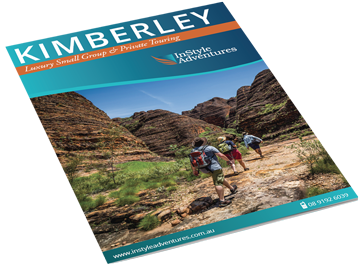THE BUNGLE BUNGLE RANGE, KIMBERLEY, WESTERN AUSTRALIA
The Bungle Bungle range (known more commonly as the Bungle Bungles), which is part of Purnululu National Park, Kimberley, Western Australia is a kaleidoscope of colour — towering striped orange and black rocks with golden splashes of wattle, lush green spinifex and cloudless blue skies lavishly reflected in shimmering water filled rock pools.
Rising 300 metres above lush grassy plains, the fascinating geological landmark known as the Bungle Bungle Range comprises vivid orange and black sandstone domes that look like monolithic tiger striped anomalies. The best view of the Bungle Bungles and Purnululu National Park is via a scenic flight tour. From the skies the scenery is utterly amazing. Flying is the best way to appreciate the geology and sheer scale of this ancient natural wonder! A 4WD bungle bungles tour by land enables you to experience an up-close and personal exploration of this most treasured Kimberley icon. It is equally unforgettable. You may also like to spend the day hiking Piccaninny Creek or discovering long narrow chasms, massive hidden gorges and an abundance of native animals and bird species. With countless tour options available from bush-camping to full or half-day tours from Kununurra, visit one of our Bungle Bungles Tours on offer below to locate the type of tour and inclusions that best suit your particular needs.
ARE YOU READY FOR AN ADVENTURE?
Click on one of our Tours below to experience this beautiful region!

Bungle Bungles Sunset
HISTORY OF THE BUNGLE BUNGLES
The Bungle Bungle Range is a gorgeous treasure chest with sparkling secrets that remained hidden until 1983 when documentary filmmakers flying high overhead unearthed the spectacular striped jewel.
Read More
The Bungle Bungle Range is a gorgeous treasure chest with sparkling secrets that remained hidden until 1983 when documentary filmmakers flying high overhead unearthed the spectacular striped jewel. Keen for a closer tour of the Bungle Bungles, they took to the ground in 4WDs and discovered their precious sparkling bounty, which later in 1987 became a National Park. The area, although unknown to the rest of the world until the mid-80s, has long been home to local Indigenous people, with the name Purnululu meaning ‘sandstone.’
HISTORY OF THE BUNGLE BUNGLES

Bungle Bungles Sunset
The Bungle Bungle Range is a gorgeous treasure chest with sparkling secrets that remained hidden until 1983 when documentary filmmakers flying high overhead unearthed the spectacular striped jewel. Keen for a closer tour of the Bungle Bungles, they took to the ground in 4WDs and discovered their precious sparkling bounty, which later in 1987 became a National Park. The area, although unknown to the rest of the world until the mid-80s, has long been home to local Indigenous people, with the name Purnululu meaning ‘sandstone.’

Bungle Bungles Sunset
EXACTLY HOW WERE THE BUNGLE BUNGLES FORMED?
Most people are fascinated by the striped sandstone formation. It was formed more than 350 million years ago from the amassed sediment of an ancient river bed.
Read More
Most people are fascinated by the striped sandstone formation. It was formed more than 350 million years ago from the amassed sediment of an ancient river bed. The residue collected in layers and compacted into sandstone to eventually rise, forming the impressive mountain range. Beginning as one large block, the weak areas and edges of the sandstone consistently were hammered by severe wet season rain and winds, as well as contrasting winter freezes and soaring 50+ Celsius degree summer heat. This caused endless cracks, deep canyons, wide creeks and chasms to form. And of course, the spectacular circular Cathedral Gorge resulted from a massive wet season whirlpool. The lighter layers have less clay with the iron in the sandstone being oxidised, resulting in the bright orange hue. The striped domes surround the edges of the range, with a new area of domes forming as the erosion continues towards the centre of the massive formation.
EXACTLY HOW WERE THE BUNGLE BUNGLES FORMED?

Bungle Bungles Sunset
Most people are fascinated by the striped sandstone formation. It was formed more than 350 million years ago from the amassed sediment of an ancient river bed. The residue collected in layers and compacted into sandstone to eventually rise, forming the impressive mountain range. Beginning as one large block, the weak areas and edges of the sandstone consistently were hammered by severe wet season rain and winds, as well as contrasting winter freezes and soaring 50+ Celsius degree summer heat. This caused endless cracks, deep canyons, wide creeks and chasms to form. And of course, the spectacular circular Cathedral Gorge resulted from a massive wet season whirlpool. The lighter layers have less clay with the iron in the sandstone being oxidised, resulting in the bright orange hue. The striped domes surround the edges of the range, with a new area of domes forming as the erosion continues towards the centre of the massive formation.

Bungle Bungles Sunset
BEST TIME OF YEAR TO VISIT?
The Bungle Bungles is stunning at the start of the dry season and the best way to get there is on a 4×4 Bungle Bungle adventure.
Read More
The Bungle Bungles is stunning at the start of the dry season and the best way to get there is on a 4×4 Bungle Bungle adventure. This is when it is most accessible by road and the common time for guided Bungle Bungle tours. The wet season, however, is utterly spectacular, although at this time the region can only be viewed by air. Weather permitting, 4WD road access into Purnululu National Park re-opens in early April. At this time of the year, the region is lush and green with bright yellow Acacia flowers an d Grevillea blooming all around the dome plains.
BEST TIME OF YEAR TO VISIT?

Bungle Bungles Sunset
The Bungle Bungles is stunning at the start of the dry season and the best way to get there is on a 4×4 Bungle Bungle adventure. This is when it is most accessible by road and the common time for guided Bungle Bungle tours. The wet season, however, is utterly spectacular, although at this time the region can only be viewed by air. Weather permitting, 4WD road access into Purnululu National Park re-opens in early April. At this time of the year, the region is lush and green with bright yellow Acacia flowers an d Grevillea blooming all around the dome plains.

Bungle Bungles Sunset
TYPICAL MONTH BY MONTH TEMPERATURES
May sees hot days well above 30 degrees and higher amongst the domes with plenty of water in the rock pools, although the water does recede quickly with pools becoming stagnant and smelly.
Read More
May sees hot days well above 30 degrees and higher amongst the domes with plenty of water in the rock pools, although the water does recede quickly with pools becoming stagnant and smelly. Mid-June to mid-August, the coolest time of the year is peak season for tourists with the weather being very pleasant during the day. However, in July temperatures can drop to below zero overnight so it’s best to ensure you have a warm sleeping bag if camping. August and September sees the weather warming up again, but the tourists drop off as the water has disappeared and the landscape has transformed to brown and dusty. October sees temperatures soaring to over 50 degrees C, with heat exhaustion being a common problem.
TYPICAL MONTH BY MONTH TEMPERATURES

Bungle Bungles Sunset
May sees hot days well above 30 degrees and higher amongst the domes with plenty of water in the rock pools, although the water does recede quickly with pools becoming stagnant and smelly. Mid-June to mid-August, the coolest time of the year is peak season for tourists with the weather being very pleasant during the day. However, in July temperatures can drop to below zero overnight so it’s best to ensure you have a warm sleeping bag if camping. August and September sees the weather warming up again, but the tourists drop off as the water has disappeared and the landscape has transformed to brown and dusty. October sees temperatures soaring to over 50 degrees C, with heat exhaustion being a common problem.

Bungle Bungles Sunset
WHEN SHOULD YOU TOUR THE BUNGLE BUNGLES?
The best time to go on a Bungle Bungle tour depends on what type of experience you are looking for, and your tolerance of weather extremes. May is ideal.
Read More
The best time to go on a Bungle Bungle tour depends on what type of experience you are looking for, and your tolerance of weather extremes. May is ideal. June, July and August are good options for anyone who is not worried about the cold weather and September is a good option for those that don’t mind the heat. Today, travellers from across the globe visit the region by plane, helicopter and 4WD to discover the wonders found within this gorgeous, natural phenomenon. Contact us today to find your perfect Bungle Bungles tour.
WHEN SHOULD YOU TOUR THE BUNGLE BUNGLES?

Bungle Bungles Sunset
The best time to go on a Bungle Bungles tour depends on what type of experience you are looking for, and your tolerance of weather extremes. May is ideal. June, July and August are good options for anyone who is not worried about the cold weather and September is a good option for those that don’t mind the heat. Today, Travellers from across the globe visit the region by plane, helicopter and 4WD to discover the wonders found within this gorgeous, natural phenomenon. Contact us today to find your perfect Bungle Bungles tour.






